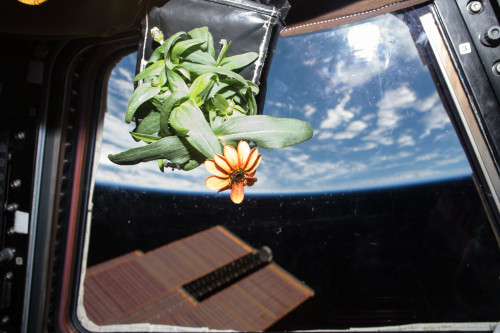People Can’t Anticipate How Much They’ll Miss The Natural World Until They Are Deprived Of It. I
People can’t anticipate how much they’ll miss the natural world until they are deprived of it. I have read about submarine crewmen who haunt the sonar room, listening to whale songs and colonies of snapping shrimp. Submarine captains dispense “periscope liberty” - a chance to gaze at clouds and birds and coastlines - and remind themselves that the natural world still exists. I once met a man who told me that after landing in Christchurch, New Zealand, after a winter at the South Pole research station, he and his companions spent a couple of days just wandering around staring in awe at flowers and trees. At one point, one of them spotted a woman pushing a stroller. “A baby!” he shouted, and they all rushed across the street to see. The woman turned the stroller and ran. Nothing tops space as a barren, unnatural environment. Astronauts who had no prior interest in gardening spend hours tending experimental greenhouses. “They are our love,” said cosmonaut Vladislav Volkov of the tiny flax plants - with which they shared the confines of Salyut 1, the first Soviet space station. At least in orbit, you can look out the window and see the natural world below. On a Mars mission, once astronauts lose sight of Earth, they’ll be nothing to see outside the window. “You’ll be bathed in permanent sunlight, so you won’t eve see any stars,” astronaut Andy Thomas explained to me. “All you’ll see is black.”
Mary Roach. Packing for Mars: The Curious Science of Life in the Void (via coneyislands)
More Posts from Fillthevoid-with-space and Others
Tampons were packed with their strings connecting them, like a strip of sausages, so they wouldn’t float away. Engineers asked Ride, “Is 100 the right number?” She would be in space for a week. “That would not be the right number,” she told them. At every turn, her difference was made clear to her. When it was announced Ride had been named to a space flight mission, her shuttle commander, Bob Crippen, who became a lifelong friend and colleague, introduced her as “undoubtedly the prettiest member of the crew.” At another press event, a reporter asked Ride how she would react to a problem on the shuttle: “Do you weep?”
Astronaut Sally Ride and the Burden of Being “The First” (via dinosaurparty)

After spending a month attached to the ISS, the Dragon spacecraft succesfully lands in the pacific and is shipped back to land.
via reddit

July 16th, 1969, 8:32 AM - Neil Armstrong, Michael Collins, and Edwin “Buzz” Aldrin Jr. lift off aboard Saturn V SA-506.
What's Made in a Thunderstorm and Faster Than Lightning? Gamma Rays!
A flash of lightning. A roll of thunder. These are normal stormy sights and sounds. But sometimes, up above the clouds, stranger things happen. Our Fermi Gamma-ray Space Telescope has spotted bursts of gamma rays - some of the highest-energy forms of light in the universe - coming from thunderstorms. Gamma rays are usually found coming from objects with crazy extreme physics like neutron stars and black holes.
So why is Fermi seeing them come from thunderstorms?

Thunderstorms form when warm, damp air near the ground starts to rise and encounters colder air. As the warm air rises, moisture condenses into water droplets. The upward-moving water droplets bump into downward-moving ice crystals, stripping off electrons and creating a static charge in the cloud.

The top of the storm becomes positively charged, and the bottom becomes negatively charged, like two ends of a battery. Eventually the opposite charges build enough to overcome the insulating properties of the surrounding air - and zap! You get lightning.

Scientists suspect that lightning reconfigures the cloud’s electrical field. In some cases this allows electrons to rush toward the upper part of the storm at nearly the speed of light. That makes thunderstorms the most powerful natural particle accelerators on Earth!

When those electrons run into air molecules, they emit a terrestrial gamma-ray flash, which means that thunderstorms are creating some of the highest energy forms of light in the universe. But that’s not all - thunderstorms can also produce antimatter! Yep, you read that correctly! Sometimes, a gamma ray will run into an atom and produce an electron and a positron, which is an electron’s antimatter opposite!

The Fermi Gamma-ray Space Telescope can spot terrestrial gamma-ray flashes within 500 miles of the location directly below the spacecraft. It does this using an instrument called the Gamma-ray Burst Monitor which is primarily used to watch for spectacular flashes of gamma rays coming from the universe.

There are an estimated 1,800 thunderstorms occurring on Earth at any given moment. Over the 10 years that Fermi has been in space, it has spotted about 5,000 terrestrial gamma-ray flashes. But scientists estimate that there are 1,000 of these flashes every day - we’re just seeing the ones that are within 500 miles of Fermi’s regular orbits, which don’t cover the U.S. or Europe.
The map above shows all the flashes Fermi has seen since 2008. (Notice there’s a blob missing over the lower part of South America. That’s the South Atlantic Anomaly, a portion of the sky where radiation affects spacecraft and causes data glitches.)

Fermi has also spotted terrestrial gamma-ray flashes coming from individual tropical weather systems. The most productive system we’ve seen was Tropical Storm Julio in 2014, which later became a hurricane. It produced four flashes in just 100 minutes!

Learn more about what Fermi’s discovered about gamma rays over the last 10 years and how we’re celebrating its accomplishments.
Make sure to follow us on Tumblr for your regular dose of space: http://nasa.tumblr.com.

HELIACAL
[adjective]
pertaining to or occurring near the sun, especially applied to such risings and settings of a star as are most nearly coincident with those of the sun while yet visible.
Etymology: Late Latin hēliac(us) < Greek hēliakós.
[Luis Tamani - Luz Solar]

We’re back in 2019 with an episode that would have been more appropriate to release during hurricane season: a discussion of the Coriolis force! This force was observed centuries ago but takes its name from the scientist who first considered it in terms of theory and physics. It has an impact on a vast range of natural phenomena, from weather patterns to ocean waves to the flights of flies and moths.
Below the cut are the glossary, transcript, a timeline of the people I mention, sources, and music credits. Send me any topic suggestions via Tumblr message (you don’t need an account to do this, just submit as anonymous). You can also tweet at me on Twitter at @HDandtheVoid, or you can ask me to my face if you know me in real life. Subscribe on iTunes to get the new episodes of my so-far-monthly-updated podcast, and please please please rate and review it. Go ahead and tell friends if you think they’d like to hear it, too!
(My thoughts on the next episode are Stephen Hawking, Hedy Lamarr, or famous comets. The next episode will go up in late February.)
Glossary
Coriolis force - a force in a rotating system that acts perpendicular to the direction of motion and to the axis of rotation. On Earth, this tends to deflect moving objects to the right in the Northern Hemisphere and to the left in the Southern Hemisphere.
Ekman transport - the net motion of fluid that results from the balance between Coriolis and turbulent drag forces.
Eötvös effect - the change in perceived gravitational force that results from eastbound or westbound movement on Earth’s surface.
Kelvin waves - an ocean wave that is trapped at the Earth’s equator and along vertical boundaries like coastlines. They move towards the equator when they have a western boundary; towards the poles when they have an eastern boundary; and make a whirlpool when they have a closed boundary, moving counterclockwise in the Northern Hemisphere and clockwise in the Southern Hemisphere.
Lagrange points - five points where three bodies can orbit each other, yet stay in the same position relative to each other in a stable configuration. L1-L3 are in line with each other, while L4 and L5 are at the points of equilateral triangles in the configuration.
prograde - when a planet spins from east to west.
Rossby number - used to determine the relative importance of the centrifugal and Coriolis forces in maps of weather patterns. A small Rossby number indicates that a weather system is strongly affected by Coriolis forces, while a large Rossby number signifies that a system is affected by inertial and centrifugal forces.
Transcript
Timeline
Giovanni Battista Riccioli, Italian (1598-1671)
Francesco Maria Grimaldi, Italian (1618-63)
Joseph-Louis Lagrange, French (1736-1813)
Gaspard-Gustave de Coriolis, French (1792-1843)
Sir William Thompson, AKA Lord Kelvin, Scots-Irish (1824-1907)
Baron Loránd Eötvös de Vásárosnamény, Hungarian (1848-1919)
Ottokar Tumlirz, Austrian (1856-1928)
Fridtjof Nansen, Norwegian (1861-1930)
Vagn Walfrid Ekman, Swedish (1874-1954)
Carl-Gustaf Arvid Rossby, Swedish-born American (1898-1957)
Sources
Coriolis Effect via the University of Oregon
Coriolis Force via Wikipedia
Coriolis effect, two centuries before Coriolis via Physics Today (Aug 2011)
Gaspard-Gustave de Coriolis via Wikipedia
Coriolis effect via National Geographic
Hurricane, cyclone, typhoon, tornado – what’s the difference? via African Reporter (Sep 2017)
Wang, B. Kelvin Waves. University of Hawaii: Honolulu, 2002.
Ocean in Motion: Ekman Transport Background via NASA
Ekman transport via Wikipedia
What is a Geodesist? via Environmental Science
“The Second Coming” by W. B. Yeats via Poetry Foundation
Intro Music: ‘Better Times Will Come’ by No Luck Club off their album Prosperity
Filler Music: ‘Ambergris’ by Tipper off their EP Fathoms
Outro Music: ‘Fields of Russia’ by Mutefish off their album On Draught

Galaxy NGC 7714 After Collision : Is this galaxy jumping through a giant ring of stars? Probably not. Although the precise dynamics behind the featured image is yet unclear, what is clear is that the pictured galaxy, NGC 7714, has been stretched and distorted by a recent collision with a neighboring galaxy. This smaller neighbor, NGC 7715, situated off to the left of the featured frame, is thought to have charged right through NGC 7714. Observations indicate that the golden ring pictured is composed of millions of older Sun-like stars that are likely co-moving with the interior bluer stars. In contrast, the bright center of NGC 7714 appears to be undergoing a burst of new star formation. NGC 7714 is located about 100 million light years away toward the constellation of the Fish . The interactions between these galaxies likely started about 150 million years ago and should continue for several hundred million years more, after which a single central galaxy may result. via NASA
js



Take a moment, look outside your window. 🌷🌼
Today is the #FirstDayOfSpring in the Northern Hemisphere, also known as the vernal equinox.
#DYK Earth’s tilted axis causes the season? Throughout the year, different parts of Earth receive the Sun’s most direct rays. So, when the North Pole tilts toward the Sun, it’s summer in the Northern Hemisphere. And when the South Pole tilts toward the Sun, it’s winter in the Northern Hemisphere.
These images are of Zinnias. They are part of the flowering crop experiment that began aboard the International Space Station on Nov. 16, 2015, when NASA astronaut Kjell Lindgren activated the Veggie system and its rooting “pillows” containing zinnia seeds.
Make sure to follow us on Tumblr for your regular dose of space: http://nasa.tumblr.com.
-
 justamusedmusings liked this · 2 weeks ago
justamusedmusings liked this · 2 weeks ago -
 whydoievenbotherwiththat reblogged this · 2 weeks ago
whydoievenbotherwiththat reblogged this · 2 weeks ago -
 sufferingplant liked this · 3 weeks ago
sufferingplant liked this · 3 weeks ago -
 star-eatenblanket reblogged this · 1 month ago
star-eatenblanket reblogged this · 1 month ago -
 narke liked this · 1 month ago
narke liked this · 1 month ago -
 qqzzx reblogged this · 1 month ago
qqzzx reblogged this · 1 month ago -
 pizzl liked this · 1 month ago
pizzl liked this · 1 month ago -
 angrylittlesliceofpizza reblogged this · 1 month ago
angrylittlesliceofpizza reblogged this · 1 month ago -
 fogandfireflies liked this · 1 month ago
fogandfireflies liked this · 1 month ago -
 eclectichellmouth reblogged this · 1 month ago
eclectichellmouth reblogged this · 1 month ago -
 mieczy-stiles liked this · 2 months ago
mieczy-stiles liked this · 2 months ago -
 hannibalbabygirlifier liked this · 2 months ago
hannibalbabygirlifier liked this · 2 months ago -
 afterbrainscan reblogged this · 2 months ago
afterbrainscan reblogged this · 2 months ago -
 markedpoint liked this · 3 months ago
markedpoint liked this · 3 months ago -
 darknsinth reblogged this · 3 months ago
darknsinth reblogged this · 3 months ago -
 siristaci reblogged this · 3 months ago
siristaci reblogged this · 3 months ago -
 oenothera-elata liked this · 3 months ago
oenothera-elata liked this · 3 months ago -
 othermanymore liked this · 3 months ago
othermanymore liked this · 3 months ago -
 phania reblogged this · 3 months ago
phania reblogged this · 3 months ago -
 bluecatwriter liked this · 3 months ago
bluecatwriter liked this · 3 months ago -
 pinkninjapj reblogged this · 3 months ago
pinkninjapj reblogged this · 3 months ago -
 another-bookwyrm reblogged this · 3 months ago
another-bookwyrm reblogged this · 3 months ago -
 shotguncartel reblogged this · 3 months ago
shotguncartel reblogged this · 3 months ago -
 jango-tango reblogged this · 3 months ago
jango-tango reblogged this · 3 months ago -
 jango-tango liked this · 3 months ago
jango-tango liked this · 3 months ago -
 blooblooblaa liked this · 3 months ago
blooblooblaa liked this · 3 months ago -
 marieyre liked this · 3 months ago
marieyre liked this · 3 months ago -
 samofnazareth-main liked this · 3 months ago
samofnazareth-main liked this · 3 months ago -
 altmoon liked this · 3 months ago
altmoon liked this · 3 months ago -
 frickatives liked this · 3 months ago
frickatives liked this · 3 months ago -
 lxxnas-sanxxl liked this · 3 months ago
lxxnas-sanxxl liked this · 3 months ago -
 redenanimous liked this · 3 months ago
redenanimous liked this · 3 months ago -
 evergreenblooming reblogged this · 3 months ago
evergreenblooming reblogged this · 3 months ago -
 uriasa reblogged this · 3 months ago
uriasa reblogged this · 3 months ago -
 kesavibesxxx liked this · 3 months ago
kesavibesxxx liked this · 3 months ago -
 peacefulmusingsc reblogged this · 3 months ago
peacefulmusingsc reblogged this · 3 months ago -
 laspadasara liked this · 3 months ago
laspadasara liked this · 3 months ago -
 ibringtherazorlight reblogged this · 3 months ago
ibringtherazorlight reblogged this · 3 months ago -
 tairevive liked this · 3 months ago
tairevive liked this · 3 months ago -
 another-bookwyrm liked this · 3 months ago
another-bookwyrm liked this · 3 months ago -
 coffeeshopdaydream liked this · 3 months ago
coffeeshopdaydream liked this · 3 months ago -
 dansevamp liked this · 3 months ago
dansevamp liked this · 3 months ago -
 joppingspree liked this · 3 months ago
joppingspree liked this · 3 months ago -
 intrxspectiv liked this · 3 months ago
intrxspectiv liked this · 3 months ago -
 how-toteleport liked this · 3 months ago
how-toteleport liked this · 3 months ago -
 trashyspaceprxnce liked this · 3 months ago
trashyspaceprxnce liked this · 3 months ago -
 eclecticelectriceccentric reblogged this · 3 months ago
eclecticelectriceccentric reblogged this · 3 months ago -
 95blink liked this · 3 months ago
95blink liked this · 3 months ago -
 leitharstjarna liked this · 3 months ago
leitharstjarna liked this · 3 months ago -
 cherrylottes liked this · 3 months ago
cherrylottes liked this · 3 months ago
A podcast project to fill the space in my heart and my time that used to be filled with academic research. In 2018, that space gets filled with... MORE SPACE! Cheerfully researched, painstakingly edited, informal as hell, definitely worth everyone's time.
243 posts
